The Corsair Hydro X Custom Water Cooling Review, on a Ryzen 9 3950X
by Gavin Bonshor on February 5, 2020 9:00 AM ESTCorsair Hydro X Build Experience
We used the Corsair Hydro X set to best effect in our testing of the ASRock X570 Aqua. To complement the review, we decided to do a full system build featuring ASRock's AMD RX 5700 XT Taichi 8 GB graphics card and other hardware which Corsair provided. Everything bar the motherboard and the AMD Ryzen 3950X processor for this build was provided by Corsair. The full system specifications and test setup are located on the next page, although the full performance of power delivery thermals combined with Corsair's Hydro X parts can be found in our ASRock X570 Aqua review. As the ASRock X570 Aqua comes fitted with its own custom water block which cools the CPU, the power delivery on the motherboard, and the chipset, we didn't use any of Corsair's water blocks for this system.
The Corsair Hydro X Aqua System: All the AMD
Since we aren't using any of Corsair's CPU or GPU blocks for this system, all of the focus is on the core components themselves including the XD5 pump and reservoir combination, a single XR7 240 mm radiator, as well as Corsair's LL120 RGB 120 mm cooling fans and it's Softline range. We did intend to use an additional 360 mm cooling radiator, but the Corsair Crystal 680X with our hardware wasn't compatible due to the ASRock X570 Aqua's larger than normal E-ATX size.
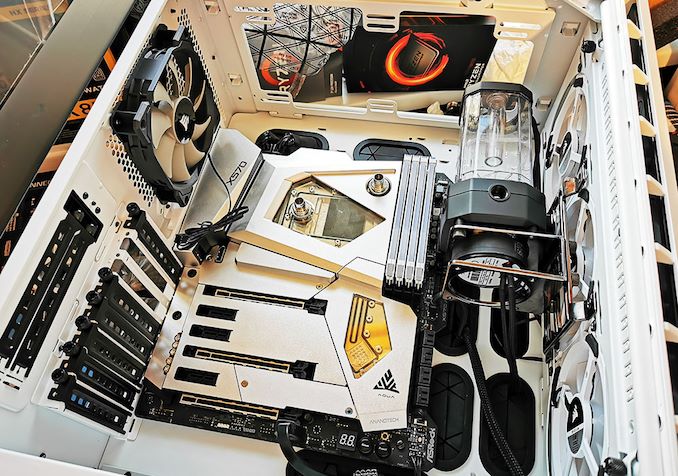
Testing possible hardware configurations inside the Corsair Crystal 680X
The first task before even unboxing the hardware was to work out which way it was going to be configured and routed around the Corsair Crystal 680X chassis. As our motherboard is E-ATX and this is technically for ATX motherboards, we did experience a couple of headaches. This wasn't to the detriment of Corsair, but more our hardware was just too big to fit in. As a result, we decided to go with a single 240 mm radiator to cool the CPU, power delivery, and chipset which the ASRock X570 Aqua block covers.
The Corsair Hydro X Series XD5 comes with mounting brackets to allow installation into various parts of a system. We decided to opt for the safer option and mount it to one of the 120 mm intake fans on the front. This was primarily to allow us to show off the XD5 in the front of the chassis, instead of mounting it in the rear chamber. The XD5 itself looks good with its nylon clear chamber, and the mounting kit is solid and sturdy.
Due to space constraints, we mounted a 240 mm radiator in a pull configuration which intakes air from the bottom of the chassis. We are using three Corsair LL120 RGB 120 mm fans in the front, with two on the radiator, and one in the rear as an exhaust. Each fan is connected to the Corsair Commander Pro controller which allows us to control everything from the Corsair iCUE software.
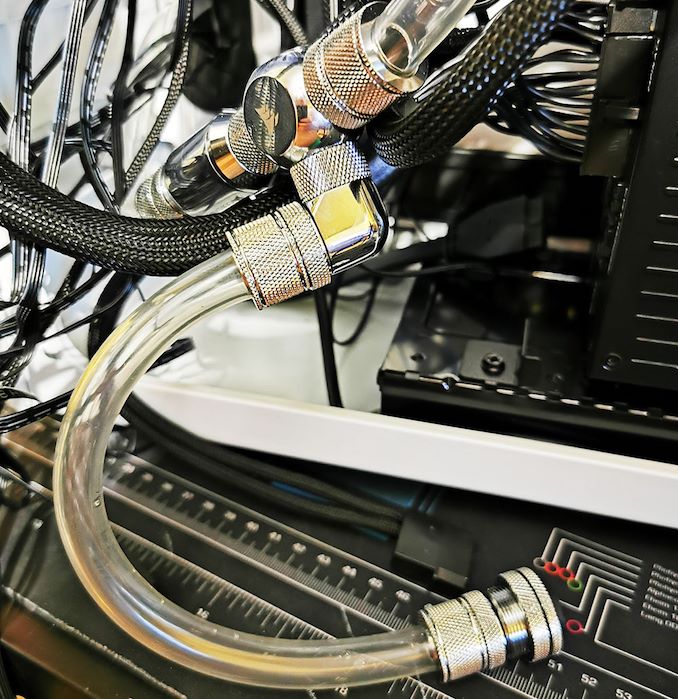
Drain port installation, should the worst happen
For better aesthetics, we routed one of the tubes through the rear chamber of the chassis, but this also allowed us to create less obstruction in the main chamber without needing to run tubing everywhere across components. For easy draining, we connected a ball valve which we can close for draining, and installed a drain port with plenty of tubing to drain without needing to dismantle the loop. This sits in the rear chamber at the bottom and is tucked away in front of the Corsair HX850 850 watt 80PLUS Platinum power supply.
After hours of countless routing and optimization of the tubing and layout, our system was complete. One thing about the Corsair Hydro X series is that it looks good, and is user-friendly making custom loop water cooling more accessible to consumers than ever before. What makes it more accessible is Corsair's Custom Cooling Configurator allows users to put in their hardware into the configurator and allow Corsair to work out what water cooling components are needed for whatever array of components are being used, or plan to be used. The Corsair Cooling Configurator is easy to use, intuitive and looks modern. This is something Corsair has put many months into designing for the end-user to make its buying decisions easy.
With the addition of the Corsair Commander RGB hub, we could connect all of the Corsair Hydro X series components including the fans and XD5 pump and reservoir combo up and sync everything up to the Corsair iCUE software; this includes the Corsair Vengeance Pro RGB memory. At present only ASUS hardware is certified to be used with Corsair iCUE in an exclusive partnership we learned about during CES 2020. As we are using ASRock hardware, we had to sync them up individually, but we like the contrasting look and having the ability to add effects.


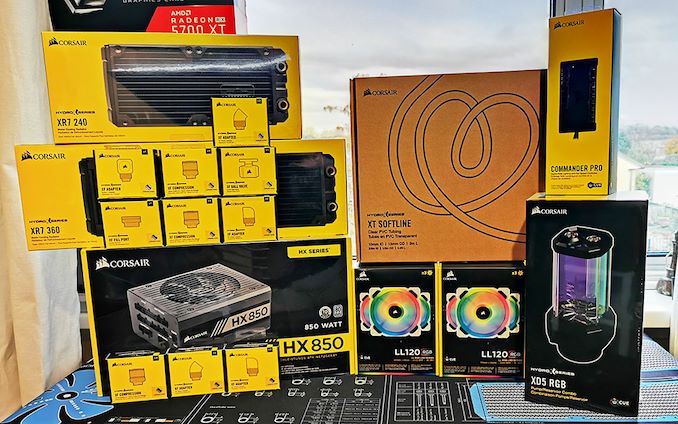

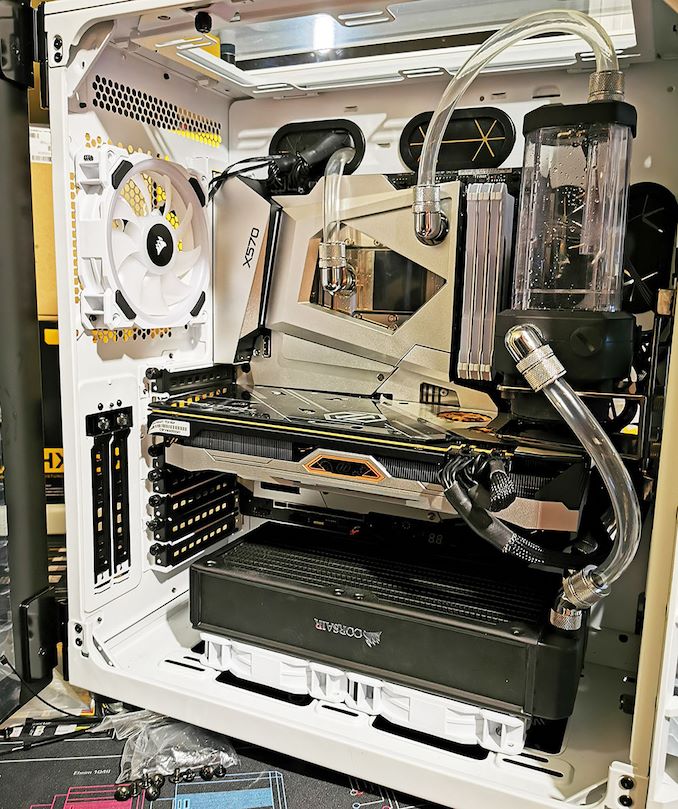
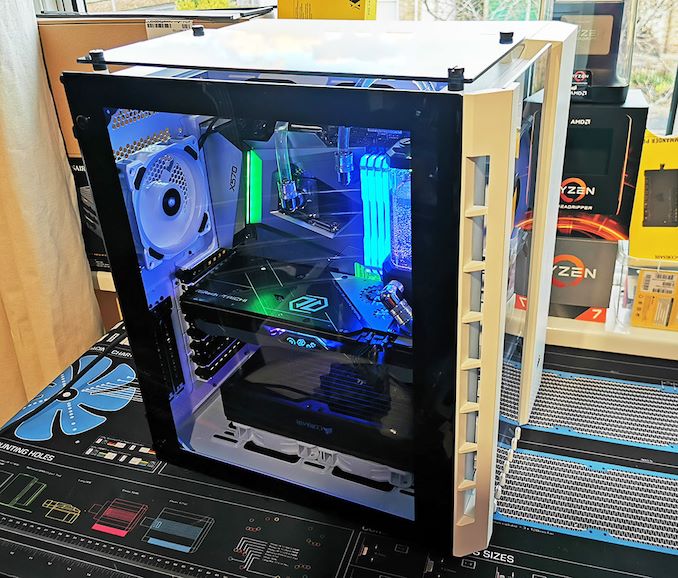
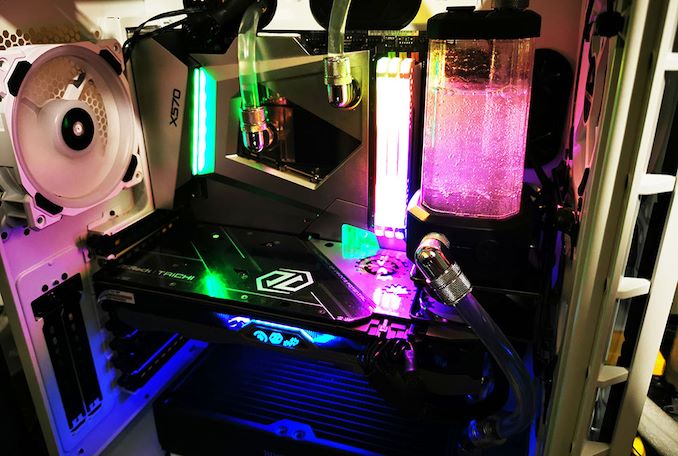








72 Comments
View All Comments
LedHed - Wednesday, February 5, 2020 - link
If you read the review, he had to use the 240mm because of space constraints (caused by the E-ATX motherboard).I wish he would have ran this guy without the ASRock power delivery H2O block/s connected.
I.E. Just shown us the performance of cooling the CPU alone, since no AIO cooler can connect to multiple blocks and the review is meant to be against AIO coolers.
Samus - Wednesday, February 5, 2020 - link
You can easily get away with a 120x38 radiator on a 84w CPU, but you will need a push and pull fan to effectively cool that radiator. I’ve run 54-65w CPU’s with full core boost enabled on cheap closed loop coolers with those thin 25mm radiators and “they work” but you need two fans and they will run at full speed during load. Don’t ask me why, it’s what the customer wanted :Pbrontes - Wednesday, February 5, 2020 - link
My bad. It's mentioned that Corsairs only amd gpu block is for 5700 XT, the test bed uses 5700 XT, but upon closer inspection of course they're using stock air cooler.Why would you ever custom loop for just the cpu.
FatBoyDiesel - Wednesday, February 5, 2020 - link
I've got a Radeon VII with an EKWB GPU block, Coolstream SE 240mm radiator, 2 EK-Furious Vardar fans, and a DDC pump. I also have a Corsair Hydro XC7 CPU block for my 3900X, all soft tubing. I'm especially curious to see the noise comparison between this setup versus air cooled Radeon VII and an H100i v2 Platinum 240mm AIO. Mind you, that AIO got pretty loud.LedHed - Wednesday, February 5, 2020 - link
As well as the common AIO coolers, like the x62, H110 and H115.Who the heck owns an ID-Cooling Auraflow 240??
anactoraaron - Wednesday, February 5, 2020 - link
Yeah this whole article seems like a corsair ad. It's almost like corsair found a very poor performing aio and sent it with everything else.AshlayW - Thursday, February 6, 2020 - link
Oh shut up. Arm-chair reviewer sat behind their monitor complaining about everything. Perhaps the author only had that model on hand at the time. They still put a lot of effort into reviewing it and you can take the Delta figures and compare to another more comprehensive AIO review elsewhere.Don't comment if you're going to post such dumb complaints.
anactoraaron - Thursday, February 6, 2020 - link
I would expect a reasonable comparison of similar coolers, popular air and aio, in a credible tech website like Anandtech. If most small time youtubers can do this it shouldn't be that difficult. What tech reviewer doesn't have an x62, h115 or h100, and a NH-D15 already? It would be like only having an AMD g3000 as the only amd chip for comparison to an intel 9900k.Looking at numbers from 'elsewhere' will have a different test bench, different ambient temps, and in general will not be similar in any way to this review.
Sit down troll. Go find an intelligent comment and try again.
PeachNCream - Thursday, February 6, 2020 - link
Let's not omit the fact that Corsair did hire someone from Anandtech so there is a connection. However, I do not believe that AT overtly advertises without making it abundantly clear content is paid for by a third party. Ryan and company may let a few typos slip here and there and yes, debating article quality is fair (including pointing out personal bias *cough* Killer NICs *cough*), but I don't think there is any reason at all to question their journalistic integrity.Drkrieger01 - Wednesday, February 5, 2020 - link
I recently put an EKWB block on my EVGA 2080 Ti. In the loop, I used a Corsair XR5 240mm radiator, and I have to say, I was very pleasantly impressed by the quality of the rad for its price. The screw/tube protectors are by far the best feature I've seen on a low cost radiator in a very long time. The cooling performance was also astronomical (can't break 52 C under max load on GPU w/overclock)